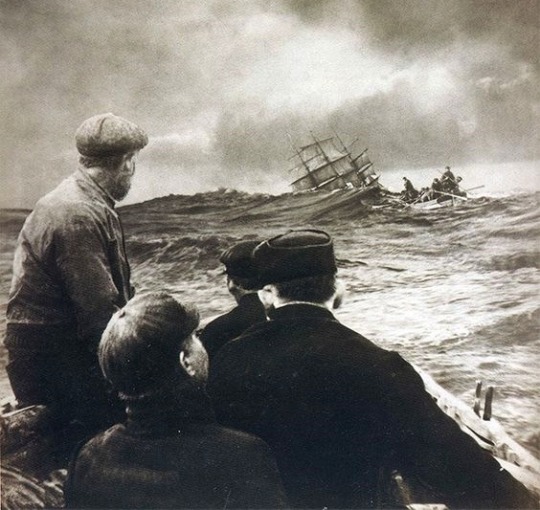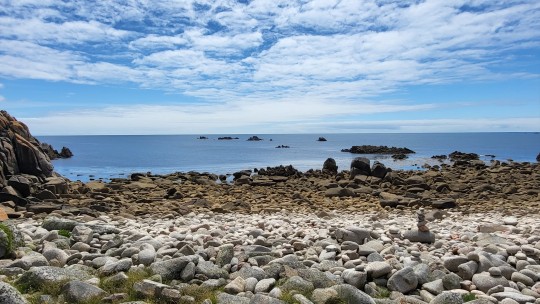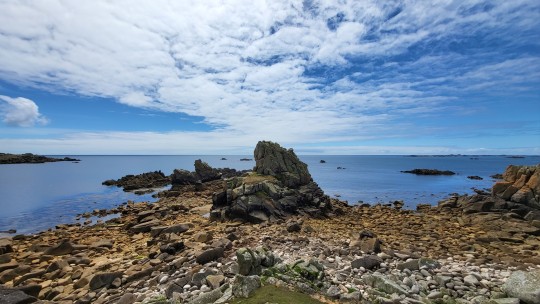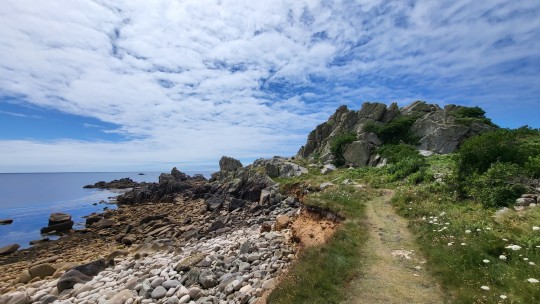#St Agnes Isles of Scilly
Explore tagged Tumblr posts
Text

A photograph by Francis J. Mortimer, a British photographer from the late 19th to early 20th centuries. This is the wreck or the Arden Craig off the Scilly Isles, England in 1911 and Mortimer is approaching in a rescue boat. Though known for his pictorial style this one crosses genres into early photojournalism while maintaining the mystique and romanticism of life on the seas.
#Francis J. Mortimer#photographer#British#Arden Craig#ship#shipwreck#Scilly Isles#England#1911#rescue boat#photojournalism#the sea#vintage photography#St Agnes Isles of Scilly#Francis James Mortimer
5 notes
·
View notes
Photo

Prehistoric Isles of Scilly
The Isles of Scilly are a small island group west of Cornwall. Despite their small size, they abound in prehistoric sites dating from the Stone Age to the Bronze Age, including cairns, burial chambers and passage graves. While prehistoric sites are found on all islands, this image gallery focuses on the two larger islands St. Mary's and St. Agnes.
While the islands are remote today, they were once directly connected by a land bridge with Cornwall, a land called "Lyonesse" in traditional legends and folklore. About 18,000 years ago, at the height of the last glacial period, the sea level was about 100 metres (328 feet) below its current level, which meant that not only were all of the Scillonian islands connected, but they represented a hilly patch towards the western end of Lyonesse.
It is in these directly connected lands that people lived and built the prehistoric monuments that we can visit today. There are likely many more found below sea level. As the ice melted, sea levels rose slowly but noticeably in a human lifetime. About 10,000 years ago, sea levels were still 30 metres (98 feet) below current levels, and around 6,000 years ago they were about 5 metres (16 feet) lower than today.
Local legends say that on what is now the Seven Stones Reef (about 1/3 of the way to Cornwall) stood a great city, the City of Lions, with a turreted castle and no less than 140 churches. As the sea swallowed the city, only one man and his horse survived, and the Vyvyan family of Cornwall claims to be descended from this man.
The Isles of Scilly are a fantastic destination for lovers of prehistory, with stunning nature and friendly people to welcome travellers.
Continue reading...
112 notes
·
View notes
Text


The Duke of Cornwall with local farmer, Tim Hicks at Troytown Farm during a visit to St Agnes, Isles of Scilly || 9 MAY 2024
#british royal family#british royals#royalty#royals#brf#royal#british royalty#Cornwall24.1.3#royaltyedit#royalty edit#my edit#prince of wales#the prince of wales#william wales#prince william#william prince of wales
93 notes
·
View notes
Photo










Wood Engraving Wednesday
HILDA QUICK
This week we present a selection of hand-colored wood engravings by the Cornish engraver and illustrator Hilda Quick (1895-1978)f rom the 8-volume fine press edition of The Works of Edmund Spenser, printed in Oxford at the Shakespeare Head Press for the publisher Basil Blackwell in an edition of 375 copies from 1930 to 1932. Quick also cut all the initials and display type that were designed by British painter and calligrapher Joscelyne Gaskin (1903-1993).
Hilda Quick was born in the town Penzance at the southern point of Cornwall, where she lived a good portion of her life, with her final 25 years of her life spent at St. Agnes, the southernmost inhabited island in the Isles of Scilly. She studied at the Central School of Arts and Crafts in London where she was trained in wood engraving by the influential wood engraver and educator Noel Rooke (1881–1953). Quick’s engravings are simple, dynamic, and elegant, and we hope to display more of her engravings from this edition in the future.
View more posts with work by by women wood engravers.
View more Women’s History Month posts.
View more posts with wood engravings!
#Wood Engraving Wednesday#women's history month#wood engravings#wood engravers#women wood engravers#Hilda Quick#Joscelyne Gaskin#The Works of Edmund Spenser#edmund spenser#Shakespeare Head Press#Basil Blackwell#fine press books#calligraphy
115 notes
·
View notes
Text

Alethea Garstin - On St Agnes, Isles of Scilly
3 notes
·
View notes
Text

21 July 2015 | Prince Charles, Prince of Wales and Camilla, Duchess of Cornwall watch a performance of St George and the Dragon by pupils at St Agnes school as they continue their tour of the Scilly Isles, in Isles of Scilly, United Kingdom. (c) Ben Birchall - WPA Pool /Getty Images
#Prince Charles#Prince of Wales#King Charles III#Camilla#Duchess of Cornwall#Queen Camilla#Britain#2015#Ben Birchall#WPA Pool#Getty Images
2 notes
·
View notes
Text

These rugged granite outcrops are at the southern end of St. Mary's Island, Isles of Scilly. On the horizon is St Agnes Island.
2 notes
·
View notes
Text

Francis James Mortimer (1874-1944) foi um pioneiro da fotografia pictórica. O mar era seu assunto favorito e ele capturou o naufrágio (1911) do Arden Craig, navio de três mastros com carregamento de trigo: o capitão ficou desorientado numa forte neblina e bateu num rochedo em St Agnes, Isles of Scilly-UK.
Photo: https://www.tumblr.com/l-will-see-your-face
1 note
·
View note
Text

The Old Rectory, St Agnes, Isles of Scilly
0 notes
Text









Had a good night on St Agnes having dinner, and I tell you it’s strange being on a boat in the dark 😂😂
504 notes
·
View notes
Text








Geology rocks, St Agnes, Isles of Scilly, Cornwall /Kernow
66 notes
·
View notes
Text

Fay Godwin
Troy Town Maze in St Agnes
Isles of Scilly, England, 1977
472 notes
·
View notes
Text
St. Warna or praying for shipwrecks
Trivia Tuesday
In which I share fun stuff I learned while doing research for my novel.

The power that dwelt in St Warna was believed to be strong over those who followed their business on deep waters. Many a time when a gallant ship was seen approaching land in safety, walking grandly upon her way, the dim shadow of the hostile Saint was thought to appear brooding like a cloud above her, and leading her unconsciously upon some one of the concealed terrors that lurked below. (Henry Whitfield)
According to Celtic and Cornish legends, St. Warna is the patron saint of shipwrecks. She is said to have traveled from Ireland to England in a small boat made of wicker and pelts. She landed on the island of St. Agnes, part of the Isles of Scilly, somewhere in the 5th or 6th century.
Not a lot is known about her, but to this day, on the island of St. Agnes areas are named after her. One of these places is a well (a fresh water source). Centuries ago, inhabitants would throw pins in the well with a prayer.
But why would anyone pray for a shipwreck?
Because then, the ship’s cargo and materials would wash up on the shore of the island: cloth, liquor, lumber, even coconuts once.
People of St. Agnes were not the only ones doing that, in fact inhabitants of the other Scilly islands did the same.
in order to make a living in the eighteenth and nineteenth centuries Scillonians gathered a sinister harvest: cargo from wrecks. According to island rumor, the trick was to entice ships into seeming safe harbors. Farmers hung lanterns around their cows' necks, intending the swinging lights to be mistaken for boats swaying at anchor at night. Jagged reefs greeted the bewildered skippers instead. While splintering hulls spilled cargo into the waves, local plunderers helped themselves from their longboats. A gasping sailor was more likely to get a blow to the head than a helping hand. (Hatsy Shields)
In 1680, a lighthouse was built on St. Agnes, operated by Trinity House (the lighthouse authority in England and Wales). I wonder how the inhabitants felt about that.

By Chris Downer, CC BY-SA 2.0, https://commons.wikimedia.org/w/index.php?curid=13100276
Sources:
British Islets by Hasty Shield in The Atlantic
Scilly and its Legends by Henry Whitfield
The Gibson Family Shipwreck Photographs
The Journal of Antiquities
#piratecore#oceancore#shipwreck#isles of scilly#legends#I did this instead of writing#so not sure it's actually helping#but I'm excited about how all these old legends#will become relevant to Evelyn and Flora's journey#trivia tuesday
9 notes
·
View notes
Video
youtube
British Flowers - Buying Flowers Online
If you're pondering requesting flowers online, you'll track down a wide scope of bouquets and learn more arrangements to browse.
Large numbers of the cut flowers that we find in florists and supermarkets are grown abroad, in nations like Holland and Kenya, however there are likewise many flower ranches in Britain. By buying British flowers, we can assist with supporting our own business flower-growers, something that it is especially important in the current monetary environment.
England has an incredible flower-cultivating industry and a few pieces of the UK have gained notoriety for creating beautiful, sweet-smelling blossoms. One of the essential districts for flower-growing in the UK is the Isles of Scilly.
The Isles of Scilly lie around 28 miles off of Land's End in the South-West of England. They comprise of five possessed islands (Bryher, St. Agnes, St. Martins, St. Mary's and Tresco) along with numerous uninhabited islands. The closeness of the Gulf Stream means that the Isles of Scilly profit with hotter winters than the remainder of the UK and infrequently experience ice or snow, while likewise having marginally cooler summers than the remainder of the country, making them the ideal location for flower ranches.
Flower cultivating initially started on the Isles of Scilly during the late nineteenth century and flowers immediately became one of the islands' fundamental fares. During World War II, the business started to endure, as it turned out to be substantially more difficult to move the flowers to the terrain, yet Winston Churchill is said to have mediated to guarantee that the flower ranchers approached fuel and transport in the wake of having been sent a bouquet of flowers from a flower rancher in the Isles of Scilly while he was in emergency clinic. From that point forward, the Isles of Scilly flower industry has grown and is fundamental to the local economy. Flower ranches on the islands are still a lot of privately-owned companies, with a large number of them having been given over through the ages.
The flower ranches on the Isles of Scilly are most popular for growing narcissi. In excess of 25 assortments of narcissi (a class of flower that includes daffodils and jonquils) are grown on the islands. Narcissi are typically white, yellow, peach or pink and numerous assortments are scented.
British flower cultivates likewise produce numerous different types of flower, including tulips and peonies. Tulips were initially found in the Middle East, yet started to be grown economically in Europe during the sixteenth century, especially in Holland. Today, numerous tulips are grown on British flower ranches. In Britain, tulips are normally reaped among January and April, so messenger the beginning of hotter climate, and they are accessible in a wide scope of assortments and colors.
1 note
·
View note
Photo

21 July 2015 | Camilla, Duchess of Cornwall and Prince Charles, Prince of Wales meet tourists as they visit St Agnes Island in Isles of Scilly, United Kingdom. (c) Chris Jackson/Getty Images
9 notes
·
View notes
Video
SCY_0578 - Telephone Box and Lighthouse - Middle Town - St Agnes by John Luxton Via Flickr: A view towards St Agnes Lighthouse which dominates the heart of this Scillonian island. Today the lighthouse functions as a day mark having been replaced in 1911 by a new lighthouse at Peninnis on St Mary's. The lighthouse contrasts nicely with the GPO K6 phone box. Camera: Contax RTSII + Carl Zeiss 50mm f1.7 Planar lens For more 35mm archive photographs of St Agnes - Isles of Scilly please click here: www.jhluxton.com/The-35mm-Film-Archive/Isles-of-Scilly/St...
#ISLES OF SCILLY#SCILLY#SCILLY ISLES#SCILLONIA#CORNWALL#KERNOW#WEST COUNTRY#ATLANTIC OCEAN#ISLAND#WWW.JHLUXTON.COM#JOHN H. LUXTON PHOTOGRAPHY#LIGHTHOUSE#TRINITY HOUSE#Telephone Box#Call box
5 notes
·
View notes